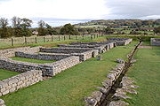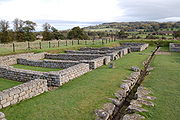
Cilurnum
Encyclopedia
Cilurnum or Cilurvum was a fort on Hadrian's Wall
mentioned in the Notitia Dignitatum
. It is now identified with the fort found at Chesters
(also known as Walwick Chesters to distinguish it from other sites named Chesters in the vicinity) near the village of Walwick
, Northumberland
, England
. It was built in 123
AD
, just after the wall's completion.
Cilurnum is considered to be the best preserved Roman cavalry
fort along Hadrian's Wall. There is a museum on the site, housing finds from the fort and elsewhere along the wall.
at this point, whose abutments survive. It was a cavalry fort at its foundation, for retaliatory raids into barbarian areas north of the wall, then given over to infantry later. Hadrian himself encouraged the "Cult of Disciplina" amongst legions stationed at the wall, and an early inscription on an altar dedicated to Disciplina
, found in 1978, indicates the earliest known military presence was a wing of cavalry, ala Augusta ob virtutem appellata ("named Augusta because of its valour"). Inscriptions have also been found showing the First Cohort of Dalmatians and the First Cohort of Vangiones
from Upper Rhineland in Germany were also stationed here.

and Estate, moved hundreds of tons of earth to cover over the last remains of the fort as part of his parkland landscaping, thereby creating a smooth uninterrupted grassland slope down to the River Tyne; he collected, before they disappeared, a number of Roman artefacts which he preserved in the family. However his son John Clayton
, a noted antiquarian
, removed all his father's work, exposing the fort, excavating, and establishing a small museum for his finds. John Clayton also made excavations at Housesteads Fort, Carrawburgh
Mithraic Temple
, and Carvoran, amongst others.
. It displays part of John Clayton's collection of Roman finds.
Hadrian's Wall
Hadrian's Wall was a defensive fortification in Roman Britain. Begun in AD 122, during the rule of emperor Hadrian, it was the first of two fortifications built across Great Britain, the second being the Antonine Wall, lesser known of the two because its physical remains are less evident today.The...
mentioned in the Notitia Dignitatum
Notitia Dignitatum
The Notitia Dignitatum is a unique document of the Roman imperial chanceries. One of the very few surviving documents of Roman government, it details the administrative organisation of the eastern and western empires, listing several thousand offices from the imperial court down to the provincial...
. It is now identified with the fort found at Chesters
Chesters (Humshaugh)
Chesters is a 17th century country mansion situated adjacent to Hadrian's Wall and the Roman fort of Cilurnum at Humshaugh, Northumberland, England. It is a Grade II* listed building....
(also known as Walwick Chesters to distinguish it from other sites named Chesters in the vicinity) near the village of Walwick
Walwick
Walwick is a village in Northumberland, England near Hadrian's Wall. Nearby villages include Humshaugh, Chollerford and Low Brunton.- Governance : is in the parliamentary constituency of Hexham....
, Northumberland
Northumberland
Northumberland is the northernmost ceremonial county and a unitary district in North East England. For Eurostat purposes Northumberland is a NUTS 3 region and is one of three boroughs or unitary districts that comprise the "Northumberland and Tyne and Wear" NUTS 2 region...
, England
England
England is a country that is part of the United Kingdom. It shares land borders with Scotland to the north and Wales to the west; the Irish Sea is to the north west, the Celtic Sea to the south west, with the North Sea to the east and the English Channel to the south separating it from continental...
. It was built in 123
123
Year 123 was a common year starting on Thursday of the Julian calendar. At the time, it was known as the Year of the Consulship of Paetinus and Apronianus...
AD
Anno Domini
and Before Christ are designations used to label or number years used with the Julian and Gregorian calendars....
, just after the wall's completion.
Cilurnum is considered to be the best preserved Roman cavalry
Auxiliaries (Roman military)
Auxiliaries formed the standing non-citizen corps of the Roman army of the Principate , alongside the citizen legions...
fort along Hadrian's Wall. There is a museum on the site, housing finds from the fort and elsewhere along the wall.
Construction
The site guarded a bridge carrying the military road behind the wall across the River North TyneRiver Tyne
The River Tyne is a river in North East England in Great Britain. It is formed by the confluence of two rivers: the North Tyne and the South Tyne. These two rivers converge at Warden Rock near Hexham in Northumberland at a place dubbed 'The Meeting of the Waters'.The North Tyne rises on the...
at this point, whose abutments survive. It was a cavalry fort at its foundation, for retaliatory raids into barbarian areas north of the wall, then given over to infantry later. Hadrian himself encouraged the "Cult of Disciplina" amongst legions stationed at the wall, and an early inscription on an altar dedicated to Disciplina
Disciplina
In Roman mythology, Disciplina was a minor deity and the personification of discipline. The word disciplina itself, a Latin noun, is multi-faceted in meaning; it refers to education and training, self-control and determination, knowledge in a field of study, and an orderly way of life. The goddess...
, found in 1978, indicates the earliest known military presence was a wing of cavalry, ala Augusta ob virtutem appellata ("named Augusta because of its valour"). Inscriptions have also been found showing the First Cohort of Dalmatians and the First Cohort of Vangiones
Vangiones
The Vangiones appear first in history as an ancient Germanic tribe of unknown provenience. They threw in their lot with Ariovistus in his bid of 58 BC to invade Gaul through the Doubs river valley and lost to Julius Caesar in a battle probably near Belfort...
from Upper Rhineland in Germany were also stationed here.

Excavation
In the early 19th century Nathaniel Clayton, owner of Chesters HouseChesters (Humshaugh)
Chesters is a 17th century country mansion situated adjacent to Hadrian's Wall and the Roman fort of Cilurnum at Humshaugh, Northumberland, England. It is a Grade II* listed building....
and Estate, moved hundreds of tons of earth to cover over the last remains of the fort as part of his parkland landscaping, thereby creating a smooth uninterrupted grassland slope down to the River Tyne; he collected, before they disappeared, a number of Roman artefacts which he preserved in the family. However his son John Clayton
John Clayton (Newcastle)
John Clayton was an antiquarian and town clerk of Newcastle upon Tyne, England during the nineteenth century. He worked with the builder Richard Grainger and architect John Dobson to redevelop the centre of the city in a neoclassical style, and Clayton Street in Newcastle is named after him...
, a noted antiquarian
Antiquarian
An antiquarian or antiquary is an aficionado or student of antiquities or things of the past. More specifically, the term is used for those who study history with particular attention to ancient objects of art or science, archaeological and historic sites, or historic archives and manuscripts...
, removed all his father's work, exposing the fort, excavating, and establishing a small museum for his finds. John Clayton also made excavations at Housesteads Fort, Carrawburgh
Carrawburgh
Carrawburgh is a settlement in Northumberland. In Roman times, it was the site of a 3½ acre auxiliary fort on Hadrian's Wall called Brocolitia, Procolita, or Brocolita This name is probably based on the Celtic name for the place, and one possible translation put forward is 'badger holes'...
Mithraic Temple
Mithraeum
A Mithraeum is a place of worship for the followers of the mystery religion of Mithraism.The Mithraeum was either an adapted natural cave or cavern or an artificial building imitating a cavern. Mithraea were dark and windowless, even if they were not actually in a subterranean space or in a natural...
, and Carvoran, amongst others.
Museum
The museum was commissioned in 1895 and opened in 1903. It is a grade II* listed building and was designed by Richard Norman ShawRichard Norman Shaw
Richard Norman Shaw RA , was an influential Scottish architect from the 1870s to the 1900s, known for his country houses and for commercial buildings.-Life:...
. It displays part of John Clayton's collection of Roman finds.
Sources
External links
- CILURNUM FORT On the line of Hadrian's Wall as it exists today
- Chesters Roman Fort - official site at English HeritageEnglish HeritageEnglish Heritage . is an executive non-departmental public body of the British Government sponsored by the Department for Culture, Media and Sport...

